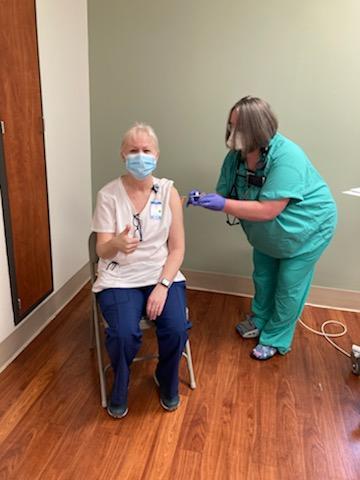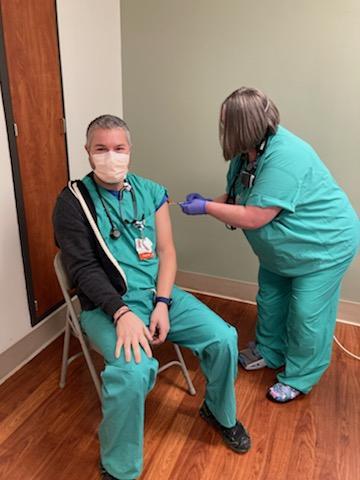SPRUCE PINE — The COVID vaccine has arrived in Mitchell County.
The first doses of the Pfizer COVID-19 vaccine arrived and were administered on Sunday, Dec. 20 at Spruce Pine Blue Ridge Regional Hospital.
During the four-hour clinic, 158 frontline healthcare workers at BRRH received the vaccine.
The first vaccine was given to registered nurse Linda Pitman of the Blue Ridge Emergency Department.
Dr. Andrew Chidester was the first physician from the Blue Ridge Emergency Department to receive the vaccine.
Mission Health also announced that it had received its first shipment of the Moderna vaccine and received word that a new batch of the Pfizer vaccine would be close behind.
Mission expects to soon have more than 3,000 doses for distribution with more shipments to come.
“The Mission Health team is so pleased with how enthusiastic our staff has been as we work through Stage 1 of vaccinating our colleagues,” said Nancy Lindell, HCA Healthcare North Carolina Division Director of Public and Media Relations.
Toe River Health District Director Diane Creek said the health department would be receiving the Moderna vaccine once it was authorized by the Food and Drug Administration (FDA), which it was on Friday, Dec. 18. Creek said they expected their allotted doses vaccine to arrive a few days after the authorization.
“We can see a small light at the end of the tunnel, but we’ve still got a long way to go,” Creek said.
The Toe River Health Department announced this past week that those among the general public who are interested in receiving a vaccine can fill out an online request form as the first step.
The form asks for basic information including name, birth date, county of residence and occupation.
Filling out the form is not required to eventually receive the vaccine, but those who fill out the form will be contacted by the health department in the future regarding what phase they can receive a vaccine in and thus get a general idea for when they can be vaccinated.
Those who fill out the form will receive a phone call or email when the vaccine is available for their assigned group.
“We’re all learning here,” said Toe River Health Director Diane Creek. “Things are changing very fast, so some of the information might change. We just have to be flexible.”
A link to the online form is available on the Mitchell County Health Department Facebook page.
Those who don’t have Facebook but are still interested in filling out the form or want more information can email mitchellhd@toeriverhealth.org or call 688-2371.
Both vaccines require two doses, with Moderna’s given 28 days apart. The Mitchell County Health Department will be receiving 600 doses to administer for the first dose and will receive the second round in a few weeks.
Neighboring Avery County will receive 600 doses and Yancey County will receive 500 doses.
In order to keep people accountable for their second dose, Creek said they will make sure they have the person’s contact information along with setting an appointment and making sure they understand.
“Before we give the first dose, we’ll definitely be having a discussion with the patient to make sure they understand they’re going to be receiving two doses of it for it to work,” Creek said. “We’ll make sure to make an appointment for the second and get all of their information so they show up for the second dose. Without the second dose, it’s a waste.”
Creek said she was fully confident the vaccine was safe and said she hoped people would not be too skeptical of it.
“Honestly, I am concerned about people’s skepticism of the vaccine, but I’m hoping that people who wait a little bit and see what happens, which most people will have to wait, can be convinced it’s safe and get the shot,” she said. “We’re not going to have herd immunity without a vaccine, because the immunity from the virus just doesn’t last long enough. If we’re ever going to get where we’re ‘back to normal’ we’re going to have to have herd immunity through the vaccine.”
While the vaccine brings some hope, Creek said people should continue to wear masks and follow the CDC guidelines until everyone has the opportunity to be vaccinated.
“People should continue to wear masks and follow the CDC precautions, because not everyone is going to be vaccinated right off the bat,” she said. “There’s also some questions about how long the immunity for this vaccine lasts. Nobody knows at this point, so, yes, people really need to continue wearing masks, keeping distance and staying home.”
The question on many people’s minds is when they will have the opportunity to be vaccinated. In North Carolina, the Department of Health and Human Services has created a four-phase vaccine distribution strategy, which is currently in Phase 1A.
In this phase, people who will receive the vaccine will include “health care workers at high risk for COVID-19 exposure based on work duties or vital to the initial COVID vaccine response” and long term care staff and residents.
In Phase 1B, people who qualify for the vaccine include groups of adults with high risk of complications with two or more chronic conditions, including migrant farm and fisheries workers, incarcerated individuals, homeless shelter residents, health care workers not included in Phase 1A and frontline workers, like police, firefighters and education staff.
In Phase 2, people who qualify for the vaccine include groups of adults without two or more chronic conditions, including migrant farm and fishery workers, incarcerated individuals, homeless shelter residents, frontline workers with high or moderate risk of exposure, all other healthcare workers not included in previous phases, education staff. Additionally, other adults age 18-64 with one chronic condition and 65+ year olds with one or no chronic conditions.
In Phase 3, “workers in industries critical to the functioning of society and at increased risk of exposure who are not included in Phase 1 or Phase 2” and students.
Phase 4 will cover the remaining population.


